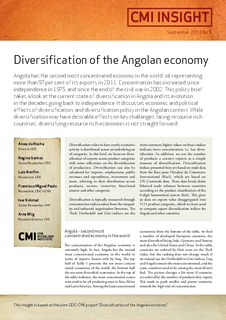| dc.contributor.author | da Rocha, Alves | |
| dc.contributor.author | Santos, Regina | |
| dc.contributor.author | Bonfim, Luís | |
| dc.contributor.author | Paulo, Francisco Miguel | |
| dc.contributor.author | Kolstad, Ivar | |
| dc.contributor.author | Wiig, Arne | |
| dc.date.accessioned | 2018-01-04T08:23:53Z | |
| dc.date.available | 2018-01-04T08:23:53Z | |
| dc.date.issued | 2014-09-01 | |
| dc.identifier | oai:www.cmi.no:5212 | |
| dc.identifier.citation | Bergen: Chr. Michelsen Institute (CMI Insight no. 2014:5) 6 p. | |
| dc.identifier.issn | 0809-6732 | |
| dc.identifier.uri | http://hdl.handle.net/11250/2475458 | |
| dc.description.abstract | Angola has the second most concentrated economy in the world, oil representing more than 97 per cent of its exports in 2011. Concentration has increased since independence in 1975, and since the end of the civil war in 2002. This policy brief takes a look at the current state of diversification in Angola and its evolution in the decades going back to independence. It discusses economic and political effects of diversification, and diversification policy in the Angolan context. While diversification may have desirable effects on key challenges facing resource rich countries, diversifying resource rich economies is not straightforward. | |
| dc.language.iso | eng | |
| dc.publisher | Chr. Michelsen Institute | |
| dc.relation | CMI Insight | |
| dc.relation | 2014:5 | |
| dc.relation.ispartof | CMI Insight | |
| dc.relation.ispartofseries | CMI Insight 2014:5 | |
| dc.relation.uri | https://www.cmi.no/publications/5212-diversification-of-the-angolan-economy | |
| dc.subject | Diversification | |
| dc.subject | Resources | |
| dc.subject | Poverty | |
| dc.subject | Angola | |
| dc.title | Diversification of the Angolan economy | |
| dc.type | Report | |
